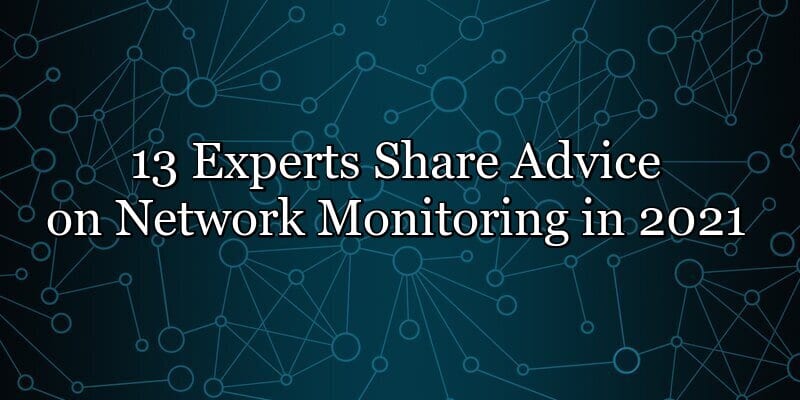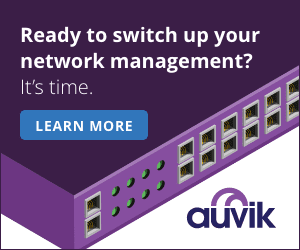13 Experts Share Advice on Network Monitoring in 2021


As part of our Networks Insight Jam, we got in touch with several experts and asked for their advice and predictions for network monitoring in 2021. These experts represent the top networking vendors, networking hardware and software providers, and IT software companies, and have decades of combined experience with monitoring and managing networks. We’ve compiled 22 quotes from 13 experts on where they see the field of network monitoring in 2021 and beyond.
Thanks to all of these experts for submitting their quotes and advice — and be sure to follow us on Twitter all day for insights, advice, and best practices on networking during our #NetworksInsightJam!
Michael Beckley, CTO and Co-founder, Appian
“Disruption is the new normal – and operational resilience will determine a company’s fate. Ongoing market uncertainty fueled by the pandemic and the seemingly never-ending acceleration of the pace of change make every day a potential “new normal” An organization’s ability to rapidly respond to change will move from “thrive” to “survive” as operational resilience changes from being a competitive advantage to being a basic requirement.”
Atul Bhatnager, CEO and President, Cambium
“Dynamic spectrum sharing will expand beyond the United States. The CBRS auction in the United States attracted billions of dollars in bids from companies we expected – and from some we didn’t. Countries around the world are dealing with problems similar to those in the United States – underserved areas stricken by interference such that major operators are unwilling to invest absent some level of spectrum access prioritization and protection. The FCC’s spectrum sharing approach to CBRS is a model that other countries will seriously consider. We predict that in 2021 at least three countries with densely populated regions will follow suit by announcing spectrum sharing methods of their own.”
Christian Gilby, Director of Enterprise Product Marketing, Mist Systems
“There will be a shift to more distributed micro-offices: SD-WAN will become increasingly important for IT departments, corporate strategy and real estate planning as businesses will prioritize setting up small micro-offices as opposed to one large campus. For IT teams, this means an increased emphasis on employees and the end-user experience from client to cloud.”
“There will be an increase in network equipment spend: COVID has created an environment of increasing network demand for high-speed connectivity and bandwidth to deliver internet solutions for employees at home. This presents an opportunity for telcos to bundle services and cohesively manage SD-WAN and value-added services, such as location-based geo-mapping, for enterprises struggling with the paradigm shift.”
Adam Hert, Senior Product Manager, SolarWinds
“Though the move from on-premises to the cloud and hybrid IT was well underway before the pandemic, this transition was accelerated by COVID-19. In 2021, traditional IT professionals will have to rethink how to best manage apps as hybrid IT becomes the new reality. One of the major challenges accompanying this is simultaneously managing legacy and modern applications. To do this effectively, tech pros will need to refocus efforts on implementing full-stack application performance management (APM) to best optimize their environments and resolve application performance problems faster and more efficiently. With integrated APM, application-level assessments such as root cause summary, response time, load patterns, and resource usage will make it easier to identify problems, allowing optimal performance and freeing up tech pros’ time. In turn, this will lessen the impact on users and the bottom line, which will be the main business priority in a post-COVID world.”
Thomas LaRock, Head Geek, SolarWinds
“Visibility is critical because database performance is often where the experience goes wrong. In 2021, it’s time to double down on database performance management. Ensuring your database performance in the cloud is at least as good as it is in your data center is critical as IT organizations “lift and shift” more workloads to the cloud—something that’s been accelerating since the workforce went remote. Otherwise, the digital transformation you expect to deliver for your business can suffer, bringing your business down with it. Because the database is critical to infrastructure and application performance, IT pros and business leaders have to strike the right balance for their organization’s growth and grapple with making their data perform its best, regardless of where it resides. And while many look at either the applications or the infrastructure supporting them, the data management itself is a top priority.”
Chris MacFarland, CEO, Masergy
“While the speeds and feeds of network design and services will remain relevant, they won’t be the most important topics companies will want to discuss in 2021. Instead, businesses will be thinking about the applications they need to support their people, their operations and their competitiveness. And for every critical decision related to operations, they will rely on their network data to connect the dots. Network data will fuel business agility, and as a result, the top questions businesses will ask of their network vendors will be around who can provide them with a strategy for accessing and analyzing the most data the fastest, how they can ensure network security while supporting distributed work environments, and how they can better utilize AI to help them optimize their operations models to gain new business insights.”
“One of the biggest lessons of 2020 was the need for companies to build work-from-anywhere (WFA) into their resiliency plans (and for many, into their business model). To be productive anywhere, workers need to connect to the network in the home or office with the same experience. While SD-WAN and SASE were not developed with the pandemic in mind, they can help enterprises better support a WFA model. In 2021, even as some employees return to the office, we will see many companies completely eliminate branch networks and rely on a software-defined model.”
“2020 was the year of the people. Everyone had to think about protecting themselves, their families, friends and colleagues in a completely different light. As businesses had to focus on the experience of people using their own devices to access the network at home and how to keep them productive, behind the scenes, every company became dependent on the IT organization, which had to “adult hard” and really dig in to keep the business running – while also working remotely themselves. As a result, in 2021, businesses will acknowledge that they don’t have all the skills they need to adapt more efficiently to whatever comes at them, especially in a distributed, hybrid world. IT will successfully make the case to rely on MSPs to drive the technology that will allow the business to make faster, better decisions about how the network is performing, how it should be utilized, and how it can be adapted and optimized to ensure employees have access to the tools, resources and insights they need for the business to thrive.”
Dr. Ritesh Mukherjee, Vice President of Product Management, 128 Technology
“New applications along with 5G and IoT will accelerate edge computing. It is one of those notable technologies that has been around for a while, has a crowded marketplace full of vendors, and has been confusing buyers forever. However, a private 5G, IoT, and an emerging array of applications requiring lower latencies will lead to the adoption of edge computing to complement public clouds, content delivery, and co-location services.”
John Pocknell, Sr. Market Strategist, Quest Software
“While aspects of DBAs jobs aren’t changing with the pandemic-caused shift to work from home, the move to remote work is evolving how DBAs stay connected and organized. Next year, we’ll see a rise in the use of collaboration tools such as Slack and Microsoft Teams leveraged by DBAs for database management and monitoring. These tools allow DBAs to automate processes and simplify working remotely with their teams to ensure no matter where they are, everyone is getting easy access to the data they need. With companies deciding how they’ll work post-pandemic — fully remote, hybrid, or in-office — we’ll see an increase in permanent use of DBAs leveraging collaboration tools in 2021.”
Mike Puglia, Chief Strategy Officer, Kaseya
“Remote management and automation are not new to the enterprise. However, they’ve taken on heightened importance as distributed workforces continue to remain the new norm and organizations are pressed to prevent a growing number of cyber-attacks. What was once easier to manage behind the corporate firewall through company issued devices is now like the lawless, wild west, with IT having to support personal device use while still maintaining security and compliance for the corporate network.”
“Most IT professionals saw their workloads significantly increase during the pandemic, facing new challenges posed by personal device use and enabling wide scale access to the corporate network. By leveraging remote management and automation solutions, IT admins can proactively manage multiple facets of the IT environment including endpoint and network monitoring, backup, compliance and security. Through automated workflows, it lessens the burden of manual oversight and empowers IT to provide better service delivery to employees, who can then perform their jobs effectively. It’s a win-win down the workforce chain.”
“IT leaders can make the most of remote management by investing in integrated remote management solutions that allow IT professionals to manage both endpoints and networks from one console. This allows technicians to reclaim the “space between,” or the valuable time IT professionals waste moving between disparate applications and processes, and allows for a more efficient allocation of internal IT team resources. Integrated remote management solutions also allow processes to be automated more easily, which saves time and makes it easier for businesses to stay compliant and secure.”
Charles Thompson, Vice President and General Manager, Enterprise and Cloud, VIAVI Solutions
“Edge computing is transforming the enterprise network. Widespread adoption of cloud-based applications requires high-speed computing at the edge in order to optimize productivity. Likewise, the need to support a distributed workforce at the edge, which began with the idea of a borderless enterprise, has only been accelerated by the necessity of remote working during the ongoing global pandemic. Together, these relentless forces are further compounding the complexity of network management, driving a greater focus on efficient, real-time response for IT operations. But edge computing doesn’t just impact service assurance. Today’s enterprise also faces growing security threats at the edge. As a result, we are seeing NetOps and SecOps teams coming together, working side by side to protect the network. Yet in order to streamline their response, NetOps and SecOps need to further break down internal silos, using common platforms and speaking the same language. To that end, IT managers should consider performance management and diagnostics solutions that provide complete network visibility and forensics capabilities, allowing operations teams to share resources to manage daily operations, solve performance issues, and mitigate risks from security threats.”
“The finance, banking, and insurance sectors are moving more quickly to embrace new technology solutions since they typically view IT as a competitive differentiator. […] Healthcare, on the other hand, is challenged due to regulatory restrictions on data security. In this case, not only is end-user access to data restricted, but network monitoring is limited by data privacy concerns, significantly reducing network visibility. With the acceleration of computing moving to the edge, traditionally conservative industries like healthcare need to reconsider their options. Healthcare IT teams that need network monitoring tools should look for platforms that provide state-of-the-art data security with encryption of data at rest, in-flight encryption, and integration with network controls such as enterprise-wide authentication, authorization, and auditing.”
Eric Troyer, CMO, Megaport
“As the pandemic took hold, 2020 for IT teams was about enabling remote work: 2021 will be about improving productivity, which will require rethinking and refining their networking and cloud strategies. As organizations accelerate their move to the cloud and adopt more flexible work models, they’ll increasingly realize that the internet doesn’t deliver the reliability, performance, and security they need for complex cloud applications and distributed workflows globally. That will lead more organizations to adopt direct private connections to their cloud services and embrace a more agile network model.”
“Additionally, reliable, low-latency cloud-to-cloud connections will become much more prevalent as organizations optimize their multi-cloud infrastructure. For example, an enterprise will then be able to store data in low-cost storage on one cloud, such as AWS or Google Cloud, and connect it directly to their Oracle or other high performance ERP system in another cloud, reducing costs while delivering the needed performance and capabilities. That’s challenging for most organizations to do today, but advances in Software Defined Networking, Network Function Virtualization, interoperability and other technologies combined with the new realities of remote work will accelerate this trend.”
Mark Winer, Senior Director of Digital Experience, Windstream Enterprise
“As various network and security technologies converge, customers will adopt solutions that can be easily managed through a single interface from their web browser and mobile devices. The days of independently managing network settings and business policies separate from their security applications are quickly becoming a thing of the past. The software applications built to support this will need to seamlessly care for this technology convergence and support future 360-degree management views and toolsets. Companies who solve and differentiate their software offers will take the lead.”
“Companies are quickly converting to remote strategies and, with the right investment, finding that it can improve their business while lowering costs. Our post-COVID world will accelerate the pressure on technology companies to deliver secure network monitoring and management solutions that offer competitive differentiation through their digital experience, as they are judged by their ease of use and the overall user experience.”
Mark Wright, Director of Marketing, AI Processors, GSI Technology
“Technologies from a variety of sectors are converging to bring about a new generation of high-speed “smart” applications. These converging technologies include IoT, faster 5G-based communications, more powerful edge compute, lower power extreme edge compute, higher functional sensors, still shrinking electronics, faster ML, and more complete AI. For the most part, development of these technologies has been heavily focused on engineering, with not enough attention being paid to the ultimate end usage. [,,,] We believe real change will come when the end applications themselves can truly benefit from multiple integrations of these technologies, such as satellites the size of your palm that can give advance warning of fires, or watches that can give early detection of major medical issues.”
“For paradigm changes to manifest across multiple sectors, businesses will need to turn a critical eye toward their choices of partnerships. The amount of software development alone required across different categories to enable these new technologies and applications will be staggering for any one company to handle. Development will be required in drivers, firmware, device software, cloud software, management software, core application software and user applications including mobile and web apps. Significant hardware development will also be required to integrate these technologies into usable form factors for new segments. And let’s not forget the integrators that will be required for the different software layer development – a key element that has been largely missing until now.”
Looking for a solution to help you improve your network performance? Our Network Monitoring Buyer’s Guide contains profiles on the top network performance monitor vendors, as well as questions you should ask providers and yourself before buying.
Check us out on Twitter for the latest in Network Monitoring news and developments!





















